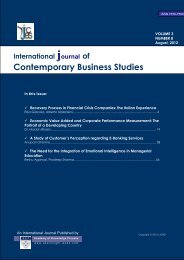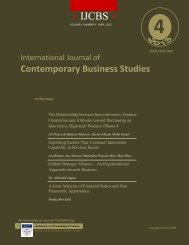Contemporary Business Studies - Academy of Knowledge Process ...
Contemporary Business Studies - Academy of Knowledge Process ...
Contemporary Business Studies - Academy of Knowledge Process ...
Create successful ePaper yourself
Turn your PDF publications into a flip-book with our unique Google optimized e-Paper software.
International Journal <strong>of</strong> <strong>Contemporary</strong> <strong>Business</strong> <strong>Studies</strong>Vol: 4, No: 2. February, 2013 ISSN 2156-7506Available online at http://www.akpinsight.webs.com4.2 Data CollectionIn this research, the primary data are collected using questionnaire survey. A questionnaire, also known asself-administered survey is handed out to certain targets or segments <strong>of</strong> people to gather data andinformation desired. For the purpose <strong>of</strong> this study, 450 copies <strong>of</strong> questionnaire were distributed. Theselected area was in Penang and the institutions selected were UniversitiSains Malaysia, INTIInternational College Penang, SEGi College Penang and Olympia College Penang.5.0 DATA ANALYSISA total <strong>of</strong> 450 sets <strong>of</strong> questionnaires were distributed to the potential respondents and a total <strong>of</strong> 387questionnaires were collected. Out <strong>of</strong> this, 23 sets <strong>of</strong> the questionnaires were considered unusable becauseover 25 percent <strong>of</strong> the questions in Part 1 – Section A <strong>of</strong> the questionnaire were not answered (Sekaran,2003). It was assumed that the respondents were either unwilling to cooperate or not serious with thesurvey. Therefore, only 364 usable sets <strong>of</strong> collected questionnaires were used for the data analysis.Thereby, the response rate was 80.89 percent. Section A collects the respondents’ demographic datawhich consists <strong>of</strong> elements such as gender, age, ethnicity, and marital status. Section B consists <strong>of</strong> sevenindependent variables, which is <strong>of</strong> this study’s main purpose: to determine the individual dispositionalcharacteristics and career capitals that affect the respondents’ perceived employability. Each variablecomprises <strong>of</strong> three to ten questions that are required to be answered by the respondents. Section C consists<strong>of</strong> six questions asking about the respondents’ perceived employability. SPSS was used to test therelationship between the independent variables and dependent variable using Pearson Correlation andMultiple Regression Analysis.5.1 Sampling Size and Technique5.1.1 Sampling SizeSampling size was defined as the number <strong>of</strong> elements to be included in the study (Malhotra, 2005).Creswell (2005) stated that “the larger the sample size, the less potential error”. Thus for this study, thebigger sampling size is more accurate in contrast to smaller sampling size and adequate size <strong>of</strong> the samplecan be used to estimate accurate actual population parameters and reduce sampling error. Candidates mustmeet three conditions or requirements before qualified as valid respondents. Proper selection <strong>of</strong>respondent is essential for the study to achieve its research objectives. Working fresh graduates, in ourstudy refers to graduates who:(i) Are fresh graduates from their respective institutions within 12 months;(ii) Currently employed and(iii) Have worked for not more than one year (12 months).In other words, graduates who were graduated for more than 12 months or have more than one year <strong>of</strong>working experience would not be deemed as working fresh graduate’s in our research context.5.1.2 Sampling TechniqueNon-probability sampling is used, instead <strong>of</strong> probability sampling because <strong>of</strong> unavailability <strong>of</strong> samplinglist which defines every element in a population. There are four types <strong>of</strong> non-probability samplingtechniques which are (i) convenience sampling, (ii) judgment sampling, (iii) snowball sampling and (iv)quota sampling. The types <strong>of</strong> non-probability sampling that were used in this study are judgmentsampling and snowball sampling.2013©<strong>Academy</strong> <strong>of</strong> <strong>Knowledge</strong> <strong>Process</strong>17
















